Posted by guest blogger Miriam Webster
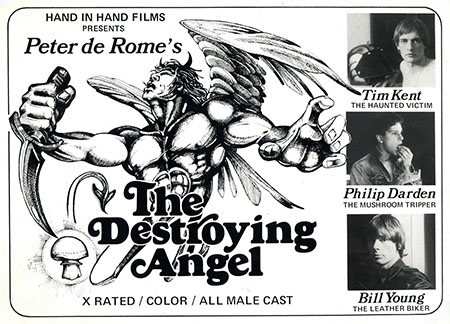
For today, I wanted to resurrect an old blog I wrote on my personal favorite movie in Bijou's catalog (and one of favorite movies in general), the 1976 Hand in Hand Films classic The Destroying Angel, which insightfully and provocatively examines one man's internal conflict over his sexuality and his place in the Catholic church. The film follows a man on sabbatical from his priestly studies who becomes - in this case, literally - fragmented into two selves in his inability to reconcile his sexual desires with his call to the cloth, while having a series of bizarre sexual experiences under the influence of psychedelics.
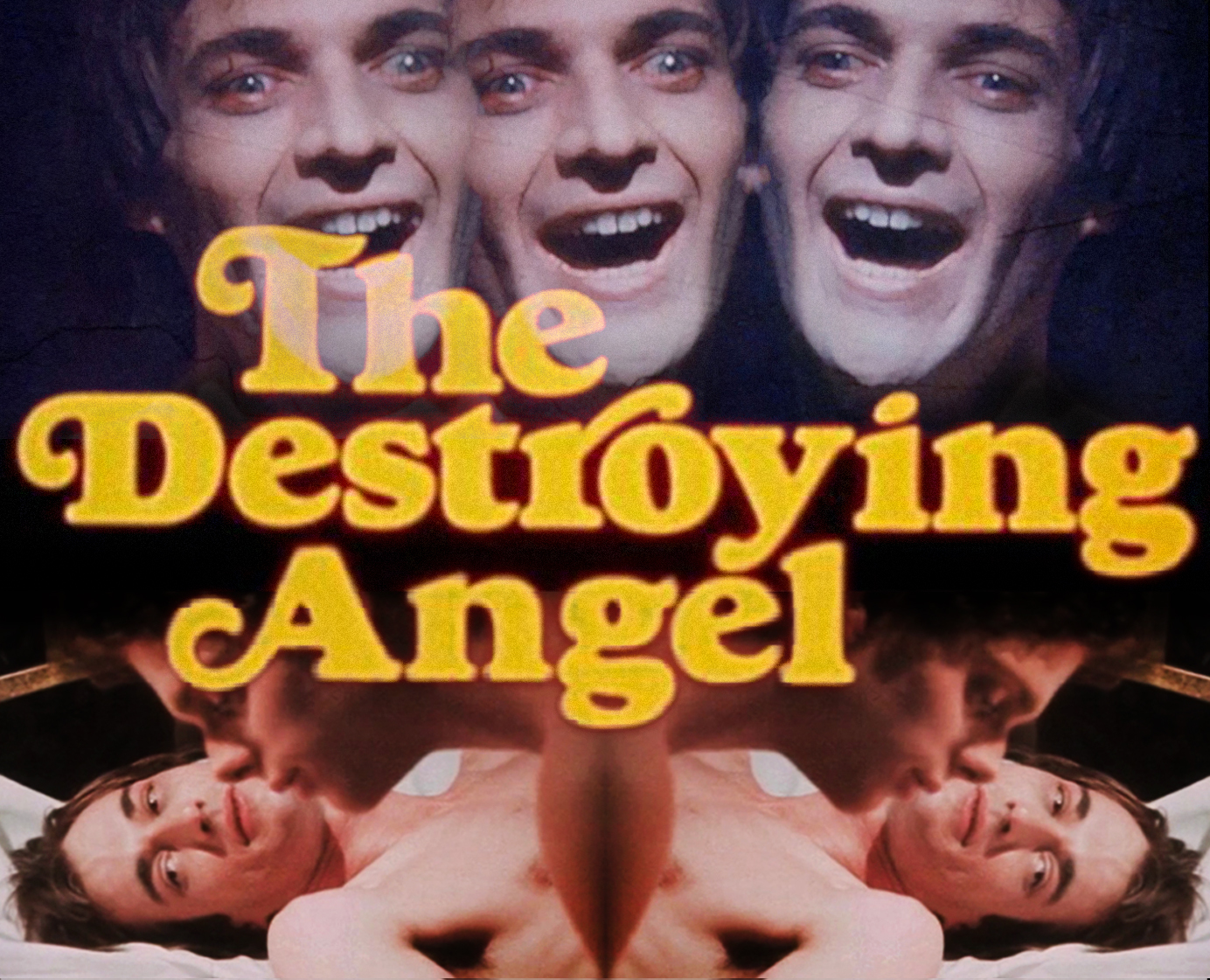
"It started with the thought that gay films had been made in various forms, but that they hadn't yet tackled the horror genre," starts celebrated gay porn auteur Peter de Rome's backstory write-up on his truly unusual 1976 horror/porn hybrid, The Destroying Angel - an entertaining, disturbing, and hallucinatory film about Catholicism, sexuality, doppelgangers, and psychoactive mushrooms. "Almost at the same time came the idea to write a story about twins - one that had been lurking in the back of my mind for a long time."
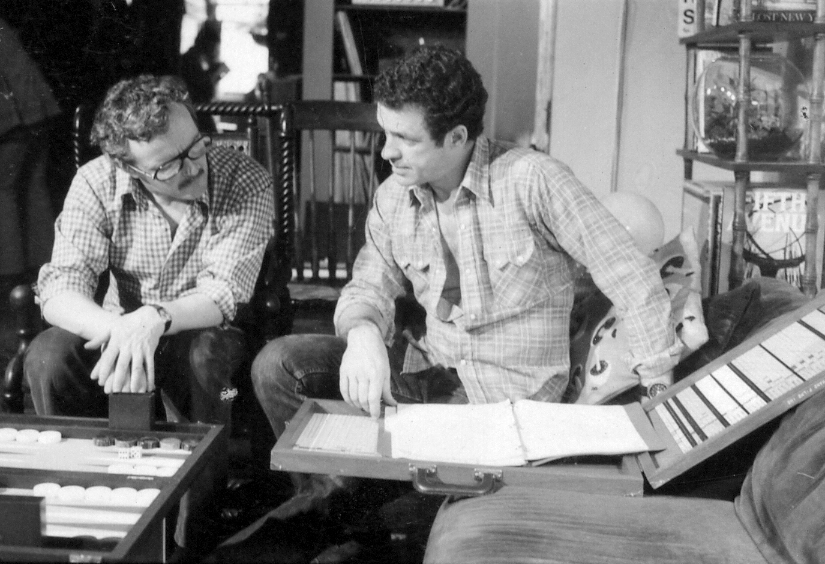
Peter de Rome and producer/cinematographer Jack Deveau on the set of The Destroying Angel
British filmmaker Peter de Rome, who passed away in 2014, was the subject of the 2016 documentary, Peter de Rome: Grandfather of Gay Porn. His work, which is both avant-garde and explicitly gay and erotic, has been widely critically recognized and written about in recent years. Working independenly on shorts in the late '60s/'70s and then with Hand in Hand in New York City in the early days of hardcore, de Rome's body of work consists of many short films and two features (1974's fascinating Adam and Yves, shot in Paris and featuring the last known footage of Greta Garbo, along with The Destroying Angel).
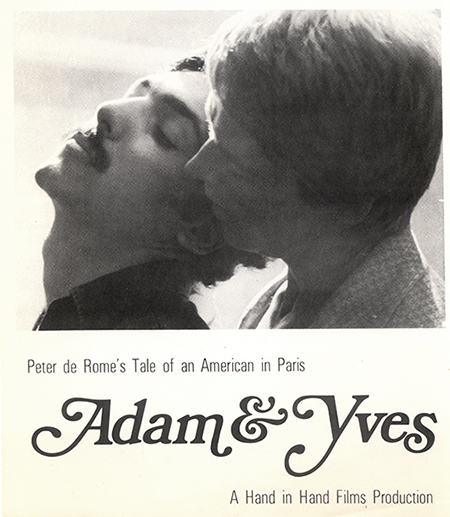
Eight of his shorts made between the years 1969 and 1972 (notably, the well-known Underground, which depicts a real sex scene shot on an active NY subway train) make up the collection The Erotic Films of Peter de Rome, released by Hand in Hand Films as the follow-up to their innagural film, Left-Handed. (For more of the studio's history, read our interview with editor/co-founder Robert Alvarez, our blog on Hand in Hand, and the 2019 book Good Hot Stuff: The Life and Times of Gay Film Pioneer Jack Deveau.) Hand in Hand also released de Rome's two features and included a few more of his short films in their compilations In Heat and Private Collection.
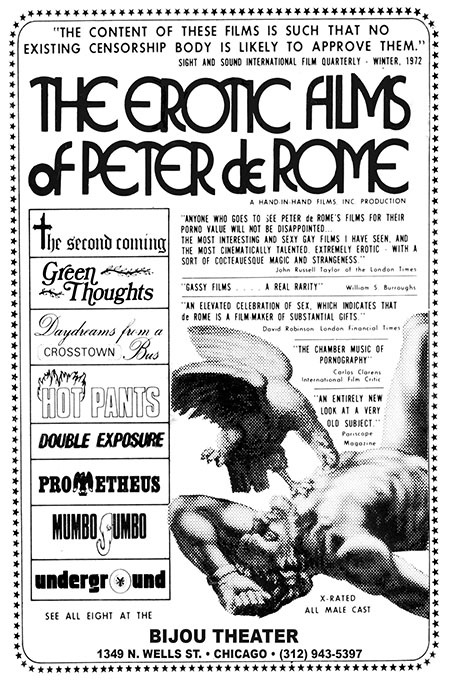
De Rome was an atypical pornographic filmmaker, largely because he had little interest in the straight-forward depiction of sex or the conventions of pornography, prefering to focus on exploring a broad, suggestive, and multi-dimensional look at sexuality through his filmmaking. "My feeling is for eroticism. And that, for me, is 'leading up to the sex.' Once you're at the sex stage it can quickly get terribly boring," he told HIM Magazine. "For me, a lot of the arousal is in the mind and the imagination. That is what really turns me on. Most of my ideas, therefore, are concerned with how we get there."
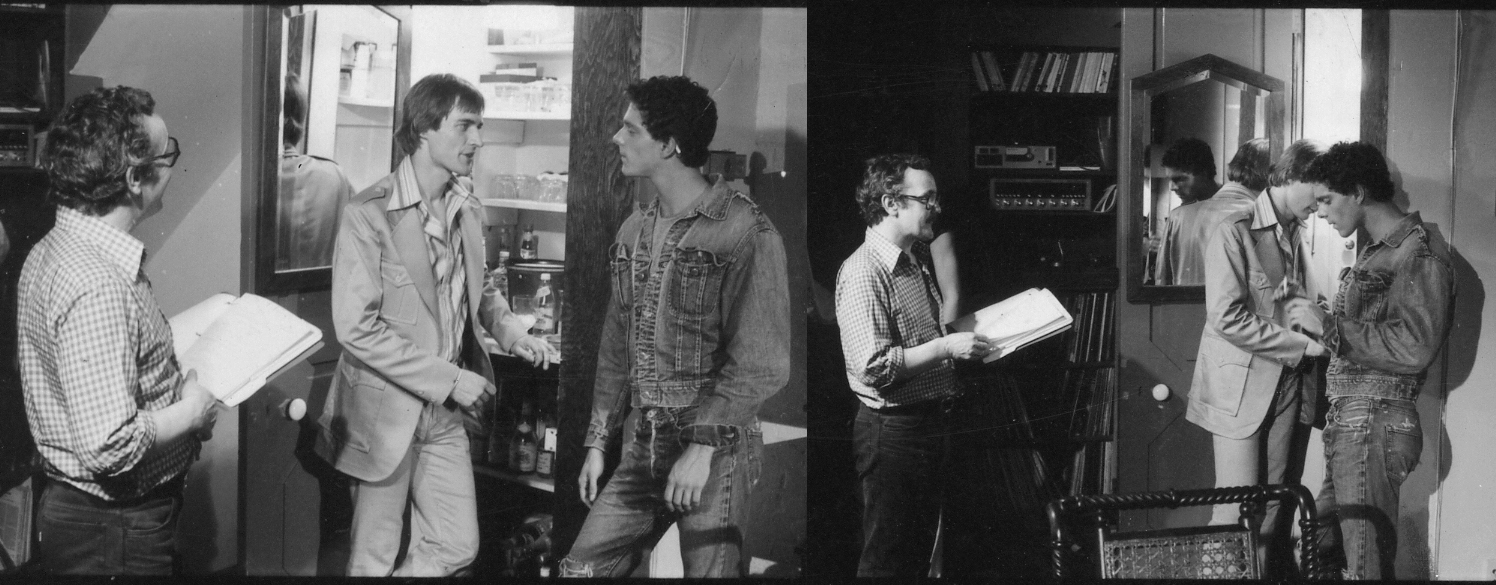
Peter de Rome directing Destroying Angel stars Tim Kent and Philip Darden
In an interview with In Touch Magazine, de Rome elaborated, "I think that we've barely scratched the surface of pornography in filmmaking, and that it has become a sort of mandatory thing in sex films to show a positive view of sex and all of sex is supposed to be the ultimate, the pinnacle of excitement, and life simply isn't like that. It seems to me that sometime we've got to get honest about sex and admit to ourselves that very few sexual encounters do work out agreeably or are completely successful. And that's one of the reasons that I did the first scene in Destroying Angel as a 'down'; it was meant to be an unsuccessful sex trip. I have a very simple if not simplistic attitude toward sex films, and that is that sex is just as much a part of life as living, eating, breathing, sleeping - it's just another function of life and I don't see why it can't be depicted dramatically just as those other funcitons are and as honestly, too. And I think we have to show every aspect of sex in films before we can really say we are making sex films."
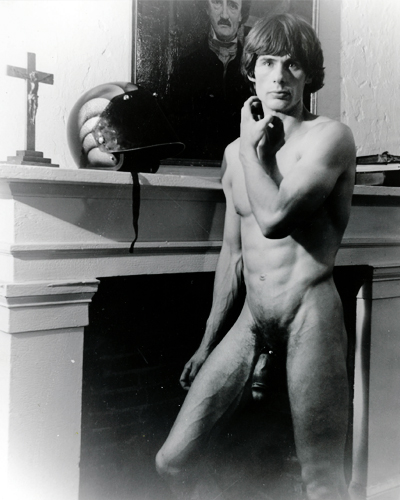
Star Bill Eld in a Destroying Angel publicity photo
Hand in Hand's press sheet on The Destroying Angel discusses the elaborateness and complexity of the production. It was shot in ten days, with twenty-two scenes in nineteen different locations "from Montauk Point to The Spike [a NYC gay bar] to Christopher Street to Brooklyn to an eighteenth century cemebery in a forgotten spot in rural New Jersey." The Spike sequence includes a barely-discernable cameo from Peter Berlin in the background. Though he's hard to spot in the film, itself, there are a few clear behind the scenes photographs of him on set.

Peter Berlin in The Spike during The Destroying Angel's filming
The press sheet also mentions that post-production took a considerable time to complete - about a year - and cites some of the filmmaking challenges present during production, primarily finding a double for the lead (Kent) with an identical body but larger cock, and shooting and constructing the doppelganger threeway scene through camera and editing tricks.
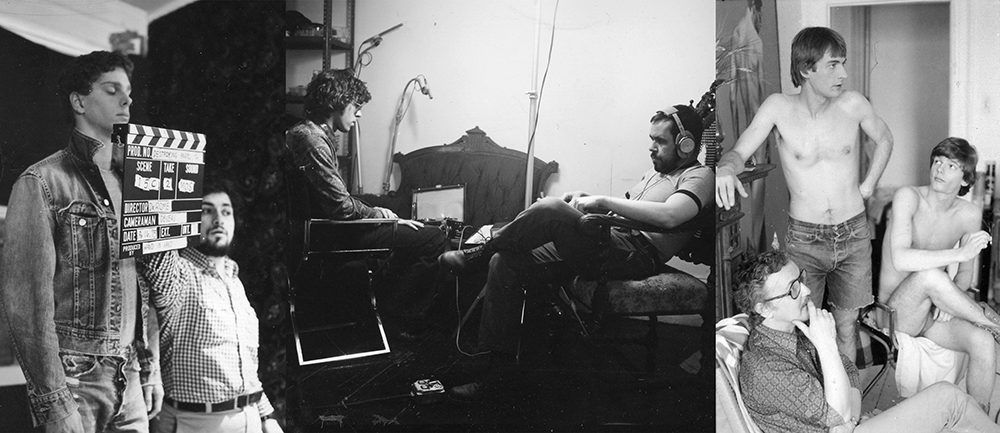
Slating, recording sound, and Peter de Rome with Tim Kent and his body double
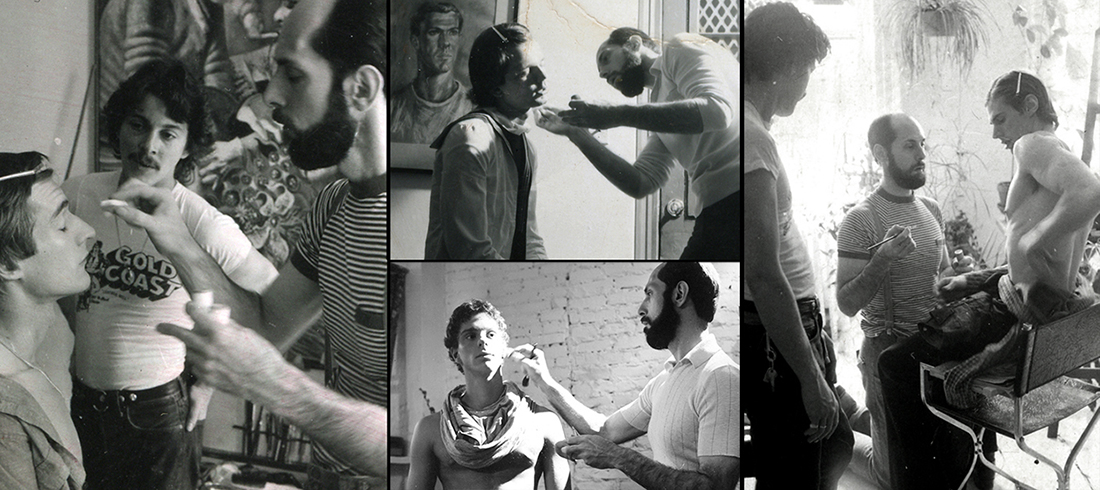
Hand in Hand make-up artist Gene Kelton prepping Kent, his body double, Darden & Eld
In Peter de Rome's backstory write-up from our files, 'Genesis of The Destroying Angel,' he goes further into the film's origin story:
By chance, I happened to read John Allegro's fascinating study, The Sacred Mushroom and the Cross, that seeks to equate Jesus Christ with a mushroom, the Amanita Muscaria. This, in turn, led me to R.G. Wasson's Soma: Divine Mushroom of Immortality, which traces the same mushroom to the Soma plant in the ancient Rigveda of India. The whole incredible story seemed to me to be a natural for erotic treatment. But how to blend the two ideas together?
I sat down at the typewriter and looked up at the painting hanging on the wall before me. It could have been a portrait of myself, except for the way he was clothed and the caption underneath: Edgar Allan Poe. Was this a sign? Maybe, but inspiration eluded me. So I went back to his stories and, sure enough, there was the answer.
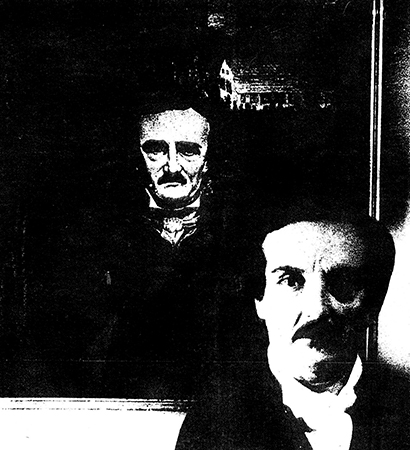
Peter de Rome in front of a portrait of his look-alike, Edgar Allan Poe
"William Wilson" provided just the sort of structure I was looking for with one important change: the twins became one troubled young man and his alter ego. A few scenes in the film are direct parallels to the story, but mostly only the structure is retained.
And then, because of the religious aspect of the mushroom story, it seemed logical to make the principle character a young priest, sorely tempted beyond his means to resist.

The urination scene derives from the hypothesis that the sacred plant called the Soma in the Vedic culture was, in fact, a hallucinogenic mushroom, a plant with miraculous inebriating virtue, enjoyed both by the peoples of the Valley of the Indus and the cattle they tended. The juice of the Soma had a similar intoxicating effect on the animals, and is excreted still in its purest form in the urine, only to be ingested once more by the peasants. This way they could stay high for days!
[This likelihood of this urine-drinking claim of Wasson's has been debated, but it seems to have caught de Rome's piss-fetishistic interest (piss-drinking also makes a tiny appearance in Adam & Yves).]

The hallucinatory piss orgy from The Destroying Angel
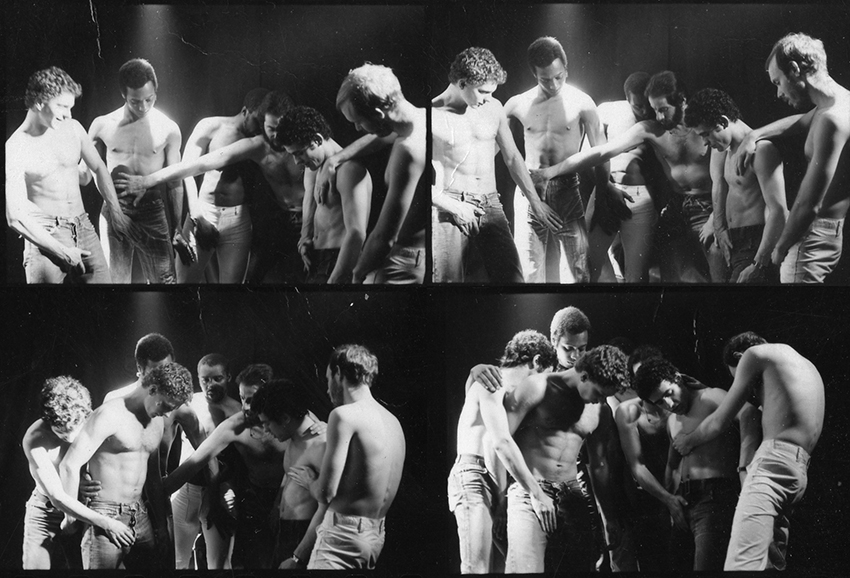
Orgy scene cast
De Rome's write-up concludes:
Small wonder that the sun became a compelling metaphor for the gleaming red-topped mushroom, and the urine its golden rays.
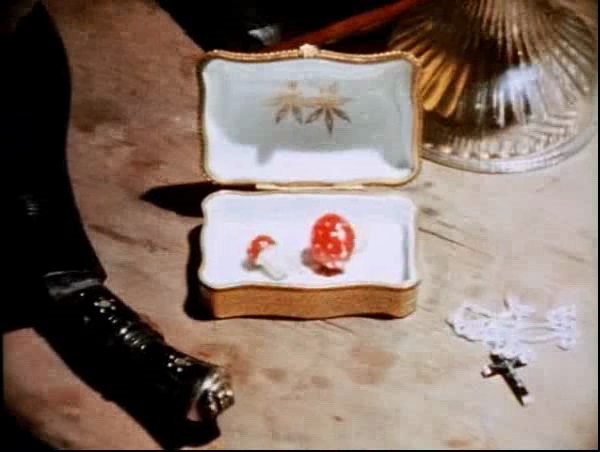
The Destroying Angel has a heavy focus on religious themes, and this was hardly first time de Rome tackled these in his films. Adam and Yves features a masturbation sequence (starring muscular Bill Eld, who also plays a prominent role in The Destroying Angel) in an 11th century French chapel, and two films in The Erotic Films of Peter de Rome (The Second Coming and Prometheus) also come to mind. Prometheus, a sort of reinterpretation of the Greek myth, focuses on a man who is brutally used by a group of strangers ushered into a room by a figure resembling Christ. The Second Coming starts off as a lark, as two men (one played by Peter de Rome, himself) travel across Europe, collecting clues that lead them from city to city. One of them winds up in an old village, where he wanders into a cathedral. A group of men are huddled together inside, looking at what initially appears to be a large crucifix on the wall in front of them. However, the figure on the cross moves - it is not Christ, but a live nude man mounted there, who ejaculates, hands free, all over his own torso.
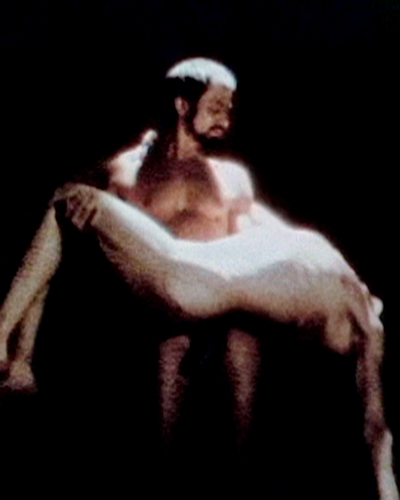
Image from Prometheus
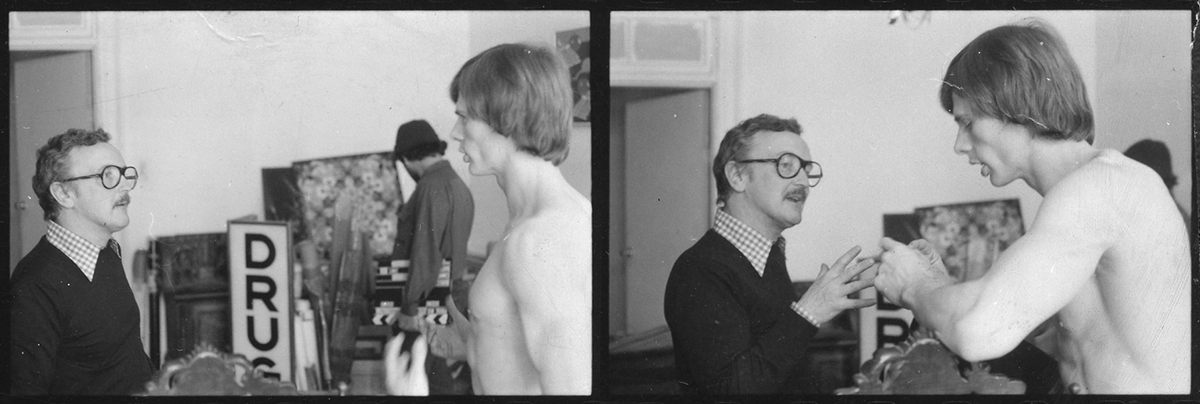
Peter de Rome and Bill Eld on The Destroying Angel's set
The Destroying Angel - a film that is simultaneously complex and campy, hot and disturbing - was de Rome's final feature, as he was, at this point in his career, growing uninterested in the increasingly graphic sexuality being demanded in pornographic films by producers and audiences. This film (referred to as "a mess but a masterpiece" by Rupert Smith) spends a larger portion of its running time on sex scenes than does Adam and Yves or most of the rest of de Rome's work, but this is not to say that it abandons de Rome's preference for erotic imagination and the underpinning motivations and forces behind sexual acts. Its sex scenes are very unlike most others, growing organically out of the lead character's inner states, becoming increasingly surreal and deconstructed over the course of the film, and serving as the means of relaying the film's themes and character development; they are integral to the movie, not diversions from the plot. And The Destroying Angel fully fuses the genres it is tackling - its sex scenes are horror scenes, making it one of porn's best and most effectively creepy horror entries.


Images from The Destroying Angel's doppelganger threeway
The sexuality depicted in the film is complicated, conflicted, compulsive; the priest character's internal struggle - rooted in religion and made terrifyingly manifest by way of hallucinogens - the source. Psychological and emotional concerns are primary within the sex scenes, which serve as the narrative, helping to make the full runtime of the film engaging as a piece of cinema (particularly as brought to life through its compelling performances, Jack Deveau's expressive camerawork, Robert Alvarez's trippy, frenetic editing, and the evocative music selections). Porn certainly needn't operate on all of these levels in order to be interesting, hot, or significant, but the multi-layered, experimental, and cinematic work of Peter de Rome is a unique and compelling type of pornographic filmmaking.
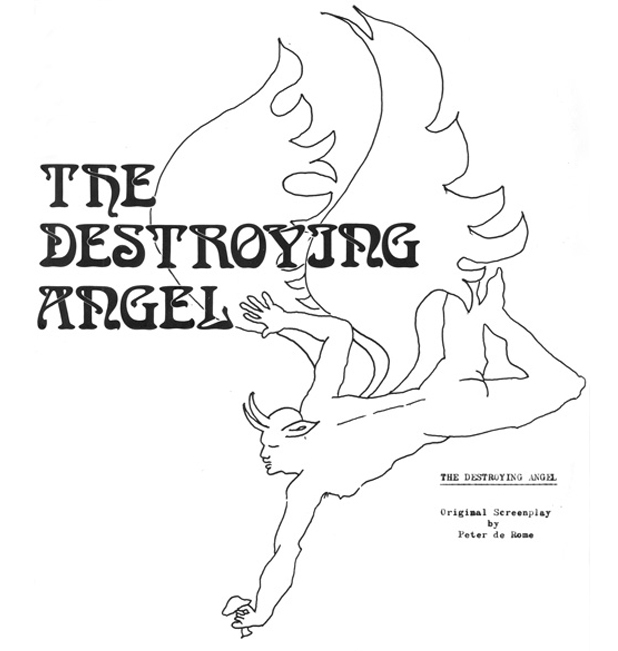
Illustration from the cover of Peter de Rome's Destroying Angel screenplay
Learn more about the backstory of this classic (including other interpretations of the film's meaning) in the Ask Any Buddy podcast episode on it.
You can watch the trailer for The Destroying Angel at BijouWorld, where you can also read more about its storyline and get the full movie on DVD, or go to our Video on Demand site to stream it! Bijou also carries Peter de Rome's other films released by Hand in Hand on DVD and Streaming.



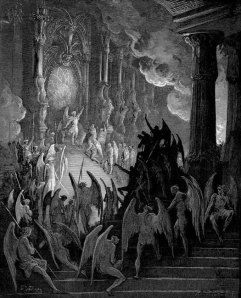
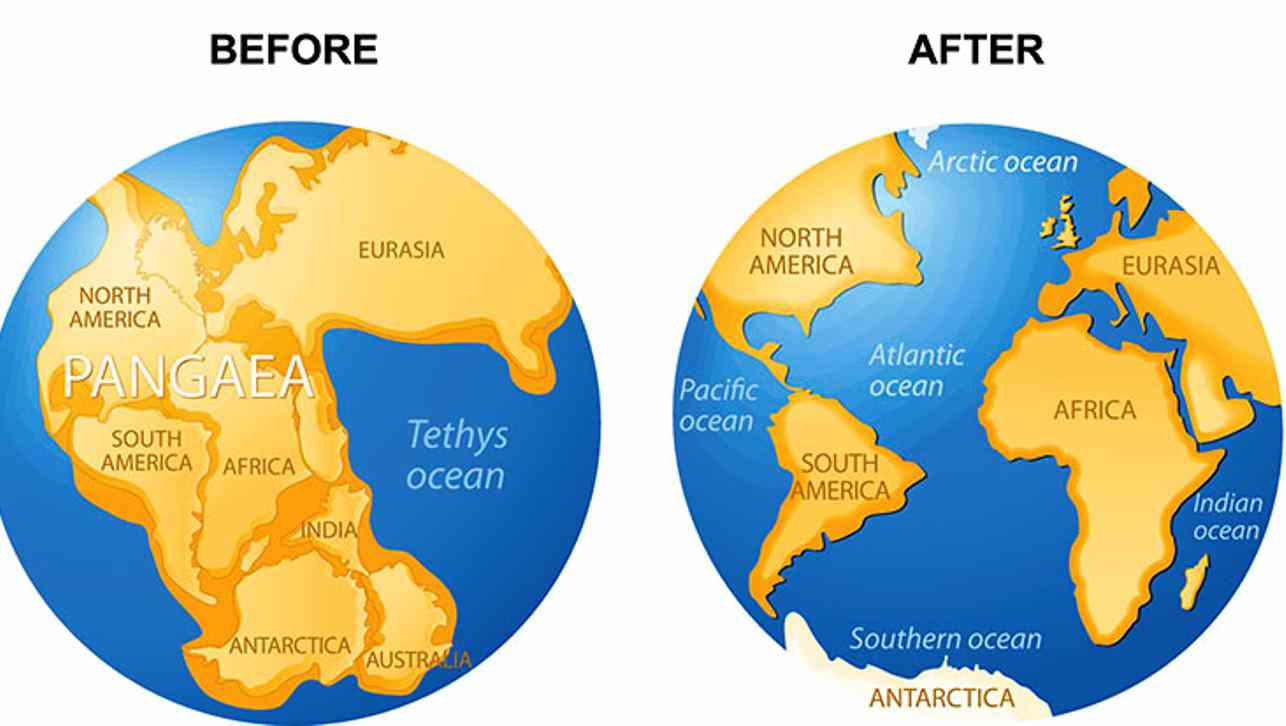
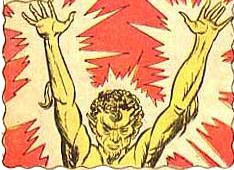
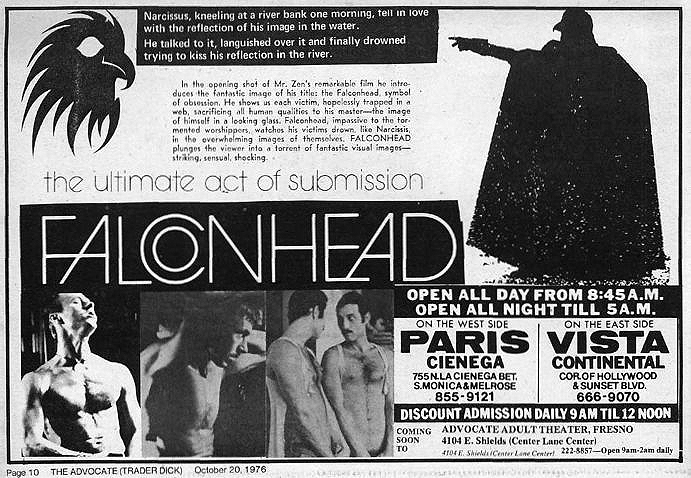
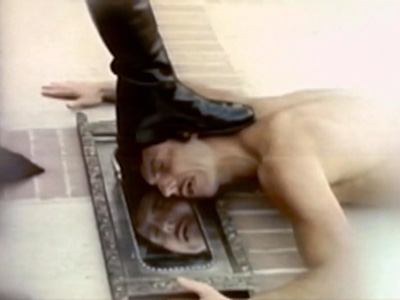

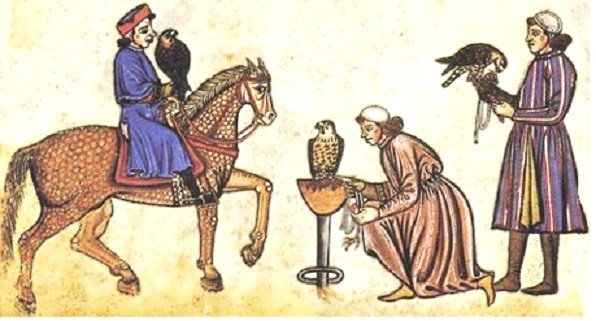
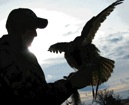

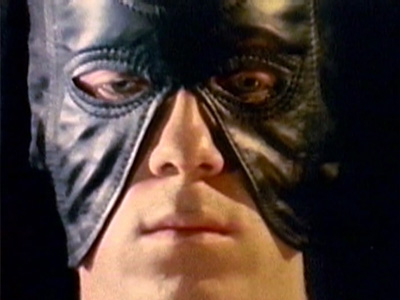
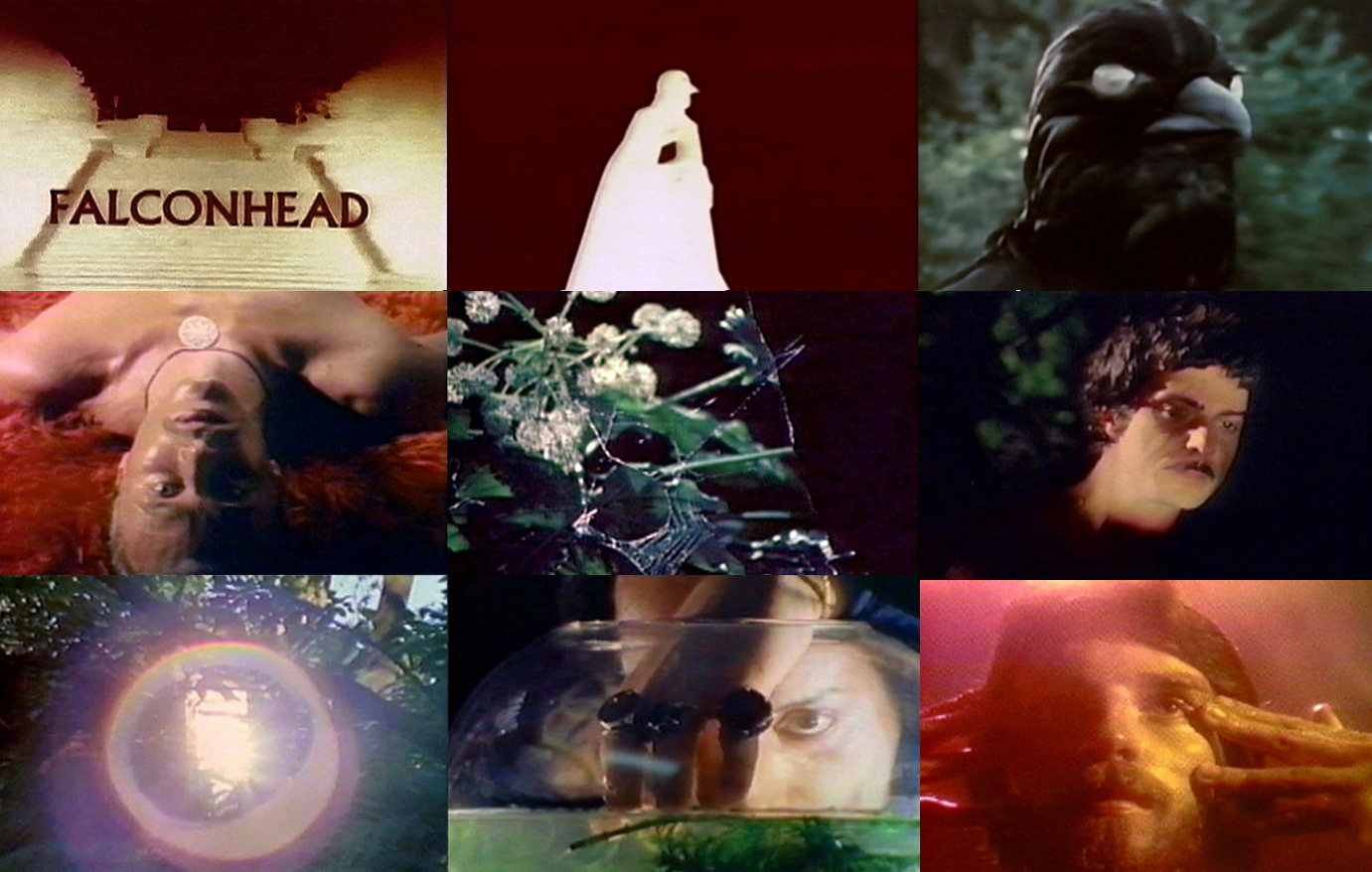


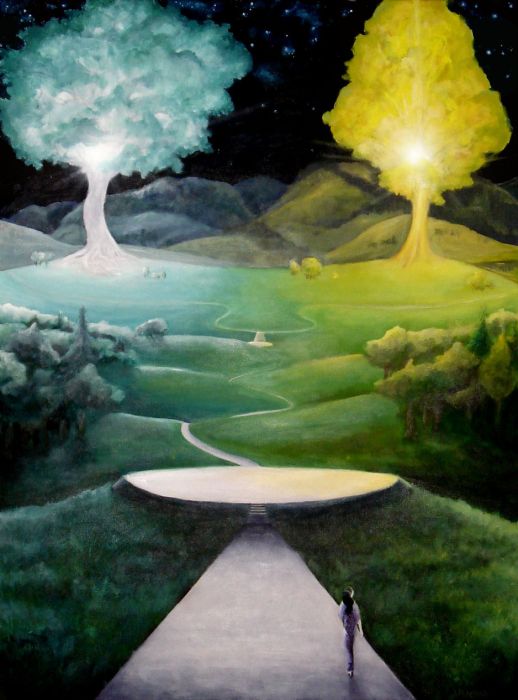


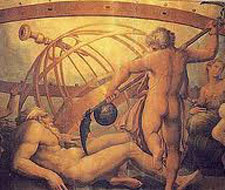
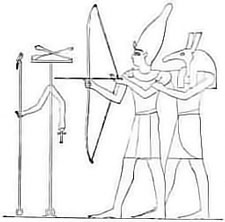
 Join our Email List
Join our Email List Like Us on Facebook
Like Us on Facebook Instagram
Instagram Youtube
Youtube Follow Us on Twitter
Follow Us on Twitter Follow us on Pinterest
Follow us on Pinterest